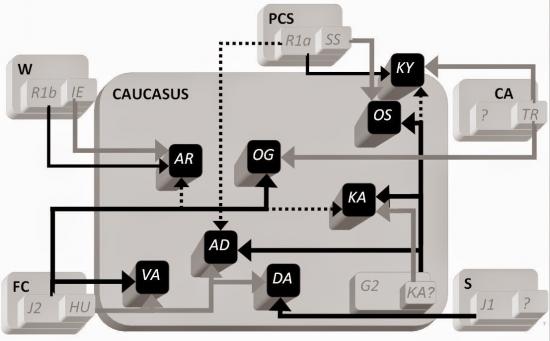Source - http://dienekes.blogspot.fr/

An interesting new study on Y chromosome and languages in the Caucasus. The distribution of haplogroups is on the left. The authors make some associations of haplogroups with language families:
-
R1b: Indo-European
-
R1a: Scytho-Sarmatian
-
J2: Hurro-Urartian
-
G2: Kartvelian

Hum Biol. 2014 May;86(2):113-30.
Human paternal lineages, languages, and environment in the caucasus.
Tarkhnishvili D1, Gavashelishvili A1, Murtskhvaladze M1, Gabelaia M1, Tevzadze G2.
Abstract
Publications that describe the composition of the human Y-DNA haplogroup in diffferent ethnic or linguistic groups and geographic regions provide no explicit explanation of the distribution of human paternal lineages in relation to specific ecological conditions. Our research attempts to address this topic for the Caucasus, a geographic region that encompasses a relatively small area but harbors high linguistic, ethnic, and Y-DNA haplogroup diversity. We genotyped 224 men that identified themselves as ethnic Georgian for 23 Y-chromosome short tandem-repeat markers and assigned them to their geographic places of origin. The genotyped data were supplemented with published data on haplogroup composition and location of other ethnic groups of the Caucasus. We used multivariate statistical methods to see if linguistics, climate, and landscape accounted for geographical diffferences in frequencies of the Y-DNA haplogroups G2, R1a, R1b, J1, and J2. The analysis showed significant associations of (1) G2 with wellforested mountains, (2) J2 with warm areas or poorly forested mountains, and (3) J1 with poorly forested mountains. R1b showed no association with environment. Haplogroups J1 and R1a were significantly associated with Daghestanian and Kipchak speakers, respectively, but the other haplogroups showed no such simple associations with languages. Climate and landscape in the context of competition over productive areas among diffferent paternal lineages, arriving in the Caucasus in diffferent times, have played an important role in shaping the present-day spatial distribution of patrilineages in the Caucasus. This spatial pattern had formed before linguistic subdivisions were finally shaped, probably in the Neolithic to Bronze Age. Later historical turmoil had little influence on the patrilineage composition and spatial distribution. Based on our results, the scenario of postglacial expansions of humans and their languages to the Caucasus from the Middle East, western Eurasia, and the East European Plain is plausible.